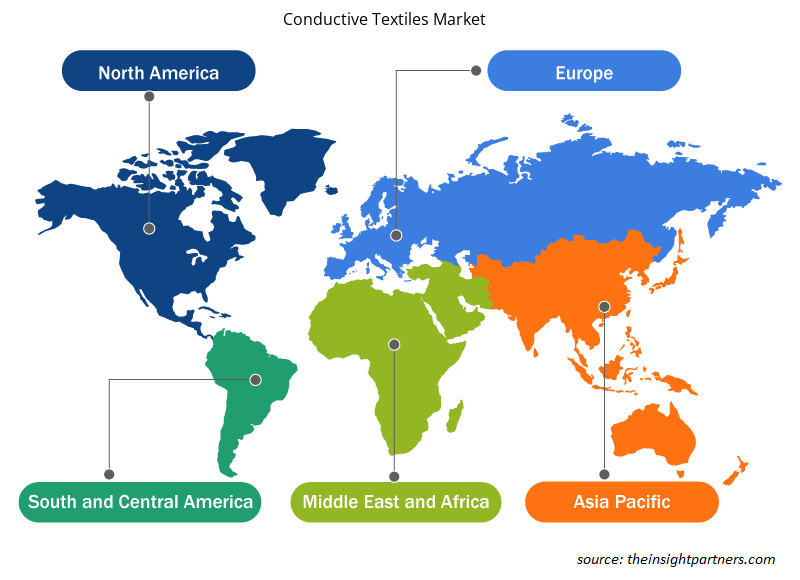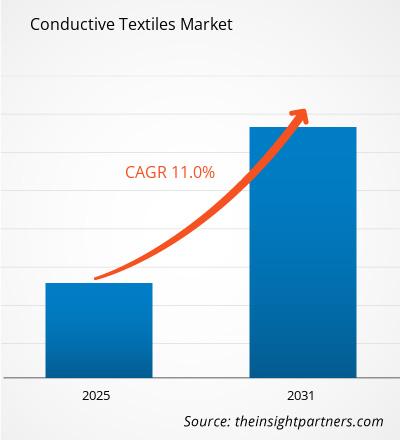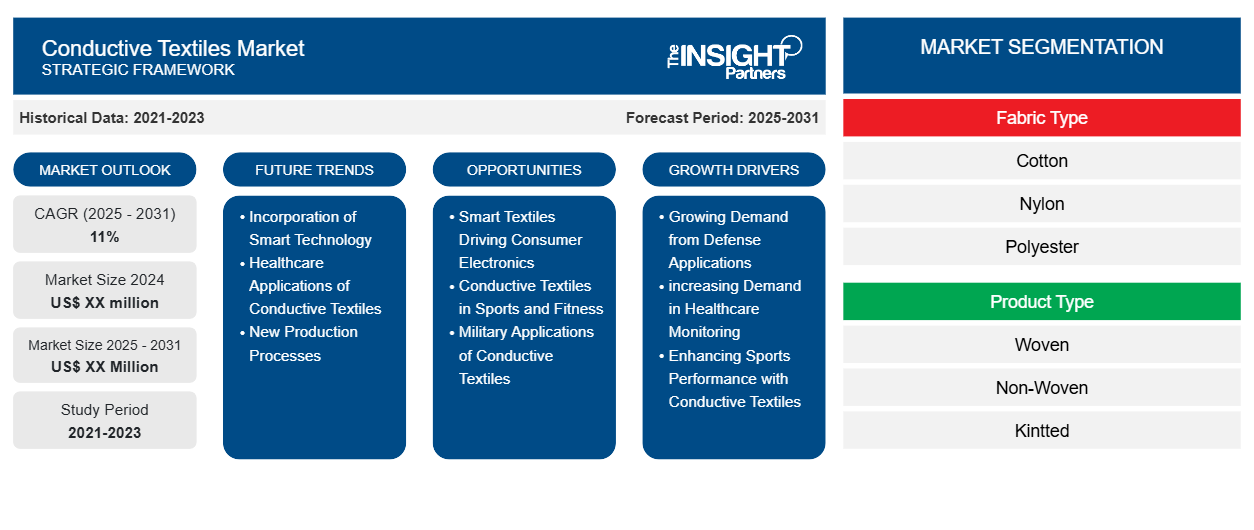导电纺织品市场预计在 2023 年至 2031 年期间的复合年增长率为 11%,市场规模将从 2023 年的 XX 百万美元扩大到 2031 年的 XX 百万美元。
报告按织物类型(棉、尼龙、涤纶、羊毛、其他)细分。报告还按产品类型(机织、非织造和针织)和最终用户(军事和国防、体育和健身、医疗保健、消费电子产品和其他)细分。报告范围涵盖 5 个地区:北美、欧洲、亚太地区、中东和非洲、南美和中美洲以及每个地区下的主要国家。全球分析进一步细分为区域和主要国家。报告以美元为单位提供上述分析和细分的价值。
报告目的
Insight Partners 发布的《导电纺织品市场》报告旨在描述当前形势和未来增长、主要驱动因素、挑战和机遇。这将为各种商业利益相关者提供见解,例如:
- 技术提供商/制造商:了解不断变化的市场动态并了解潜在的增长机会,从而能够做出明智的战略决策。
- 投资者:对市场增长率、市场财务预测以及整个价值链中存在的机会进行全面的趋势分析。
- 监管机构:监管市场政策和警察活动,旨在最大限度地减少滥用行为,维护投资者的信任和信心,维护市场的完整性和稳定性。
导电纺织品市场细分
面料类型
- 棉布
- 尼龙
- 聚酯纤维
- 羊毛
产品类型
- 编织
- 无纺布
- 编织
最终用户
- 军事和国防
- 运动与健身
- 卫生保健
- 消费电子产品
地理
- 北美
- 欧洲
- 亚太
- 南美洲和中美洲
- 中东和非洲
地理
- 北美
- 欧洲
- 亚太
- 南美洲和中美洲
- 中东和非洲
定制此报告以满足您的需求
您可以免费定制任何报告,包括本报告的部分内容、国家级分析、Excel 数据包,以及为初创企业和大学提供优惠和折扣
-
获取此报告的关键市场趋势。这个免费样品将包括数据分析,从市场趋势到估计和预测。
导电纺织品市场增长动力
- 国防应用需求不断增长:导电纺织品市场主要由军事和国防工业支持。这些行业需要精密材料用于智能应用,例如智能服装或基于生物传感器的设备。导电纺织品有助于执行作战任务并有助于提高安全水平,因此在现代军队中具有重要意义。
- 医疗监测需求不断增长:导电纺织品市场出现激增,主要是由于对智能医疗设备的需求增加。基于导电纺织品的设备(如可穿戴健康监测设备)能够在给定时间段内测量某些参数,例如心率和血压等其他生命体征。这有助于患者护理和远距离监测,因此随着医疗保健系统的不断发展,导电纺织品非常重要。
- 利用导电纺织品提高运动表现:体育和健身行业也在利用导电纺织品来提高运动员的表现和训练水平。先进的织物在穿戴时使用导电纤维作为集成智能纺织品,可以记录生物特征信息,帮助专业运动员获取活动模式的监测信息。这鼓励了运动服新设计的开发,为生产商提供了提供嵌入软电子元件的先进优化纺织品的机会。
导电纺织品市场未来趋势
- 智能技术的融入:另一个促进导电纺织品市场增长的重要趋势是将智能技术融入纺织品。这一代人的需求源于消费者对解决方案的需求,而消费者又期望制造商生产能够监测健康参数并提高其可用性的织物。这种趋势在可穿戴设备行业中随处可见,因为该行业的实用性和舒适度非常重要。
- 导电纺织品的医疗保健应用:导电纺织品市场进一步细分为医疗保健、干扰解决方案和加热,其中第一部分包括患者监测和康复。智能纺织品能够提供患者生命体征的实时信息,从而增强患者护理和治疗效果。这不仅是消费者的勇敢无畏,几乎适用于所有行业,而且它正在转化为医疗保健行业的发展,其中此类穿戴已成为医疗实践中不可或缺的一部分。
- 新的生产工艺:新生产工艺的改进正在改变导电纺织品的外观和性能。有新的方法,如涂层和嵌入导电材料,可以改善所制造带子的耐磨性。这些方法还有助于生产重量轻、柔韧且功能强大的织物,考虑到各种工业用途,如运动、军事和设计师服装。
导电纺织品市场机会
- 智能纺织品推动消费电子产品:智能纺织品在消费电子产品中的应用越来越受欢迎,这为市场带来了巨大的前景。随着技术的发展,企业可以制造出能够轻松通过各种设备实现功能的织物,从而改善用户体验。这包括智能服装和其他创新产品,包括健康调节配件,从而推动了这一细分市场的增长和发展。
- 运动和健身中的导电纺织品:使用导电纺织品来鼓励运动和健身活动正成为一种新兴趋势。市场上还出现了能够与用户互动、同时测量生物特征并向用户发送有用信息的响应式智能服装。这一发展提高了训练效率,也吸引了越来越多出于健康原因而喜爱高性能装备的人群。
- 导电纺织品的军事应用:就这些织物而言,军事部门尤其对导电纺织品非常感兴趣,特别是在智能制服和制服领域。这种纺织品有可能嵌入用于评估单个士兵的健康和环境状况的设备。军事开支和技术进步的增加,加上功能性纺织品在军队中的使用,预示着实施新型纺织品的压力将大大增加。
导电纺织品市场区域洞察
Insight Partners 的分析师已详尽解释了预测期内影响导电纺织品市场的区域趋势和因素。本节还讨论了北美、欧洲、亚太地区、中东和非洲以及南美和中美洲的导电纺织品市场细分和地理位置。

- 获取导电纺织品市场的区域特定数据
导电纺织品市场报告范围
| 报告属性 | 细节 |
|---|---|
| 2024 年的市场规模 | XX 百万美元 |
| 2031 年市场规模 | XX 百万美元 |
| 全球复合年增长率(2024 - 2031) | 11% |
| 史料 | 2021-2023 |
| 预测期 | 2025-2031 |
| 涵盖的领域 |
按面料类型
|
| 覆盖地区和国家 |
北美
|
| 市场领导者和主要公司简介 |
|
导电纺织品市场参与者密度:了解其对业务动态的影响
导电纺织品市场正在快速增长,这得益于终端用户需求的不断增长,而这些需求又源于消费者偏好的不断变化、技术进步以及对产品优势的认识不断提高等因素。随着需求的增加,企业正在扩大其产品范围,进行创新以满足消费者的需求,并利用新兴趋势,从而进一步推动市场增长。
市场参与者密度是指在特定市场或行业内运营的企业或公司的分布情况。它表明相对于给定市场空间的规模或总市场价值,有多少竞争对手(市场参与者)存在于该市场空间中。
在导电纺织品市场运营的主要公司有:
- 科泰克工业公司
- 宇部兴产
- 圣戈班
- 杜邦公司
- 东丽株式会社
- 钟渊株式会社。
免责声明:上面列出的公司没有按照任何特定顺序排列。

- 了解导电纺织品市场主要参与者概况
主要卖点
- 全面覆盖:报告全面涵盖了导电纺织品市场的产品、服务、类型和最终用户的分析,提供了整体概况。
- 专家分析:报告基于对行业专家和分析师的深入了解而编写。
- 最新信息:该报告涵盖了最新信息和数据趋势,确保了其与业务的相关性。
- 定制选项:此报告可以定制以满足特定客户要求并恰当地适应业务策略。
因此,导电纺织品市场研究报告有助于引领解读和了解行业情景和增长前景。尽管可能存在一些合理的担忧,但本报告的总体优势往往大于劣势。
- 历史分析(2 年)、基准年、预测(7 年)及复合年增长率
- PEST和SWOT分析
- 市场规模、价值/数量 - 全球、区域、国家
- 行业和竞争格局
- Excel 数据集
近期报告
客户评价
购买理由
- 明智的决策
- 了解市场动态
- 竞争分析
- 客户洞察
- 市场预测
- 风险规避
- 战略规划
- 投资论证
- 识别新兴市场
- 优化营销策略
- 提升运营效率
- 顺应监管趋势























 获取免费样品 - 导电纺织品市场
获取免费样品 - 导电纺织品市场